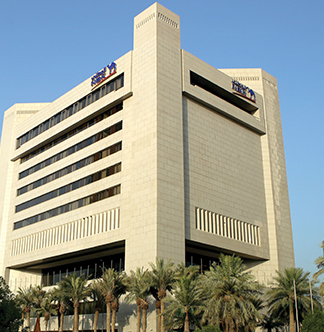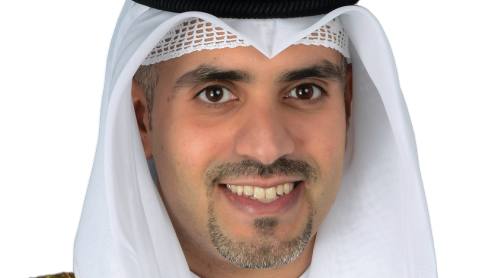These are good times to be a banker in Kuwait. As the country's government pushes ahead with its ambitious reform programme, new growth opportunities are opening up. Positive developments in the non-oil economy, which grew by 2.5% in 2017, are expected to drive the performance of most lenders over the medium term.
This partly explains why Kuwaiti banks have registered such positive results over the past year, despite a contraction in the wider economy linked to oil production cuts. Today, profits are up, asset quality is sound, and capital and liquidity ratios are healthy.
Record profits
The performance of the National Bank of Kuwait (NBK), the country’s largest lender, reflects this general trend. “Last year’s performance was exceptional on all fronts; we achieved net profits of Kd322.4m [$1.07bn] in 2017, growing by 9.2% year on year. This is equivalent to $1.1bn, making it an extraordinary year with record profits for the group," says Shaikha Al-Bahar, the bank's chief executive.
NBK’s net operating income grew by 10.4% over 2017, while its net interest income and non-interest income both jumped by 10%. “These profits were driven by core banking activities and increased business volumes, which we believe will continue to be the outlook for 2018 as well,” says Ms Al-Bahar.
Indeed, most of Kuwait’s banks registered growth rates that far exceeded gross domestic product (GDP) numbers. And with non-oil growth expected to hit a robust 3.5% in 2018 and 4% in 2019, largely driven by government spending, according to ratings agency Moody’s, most banks can expect this kind of development to continue.
“If you look at Al Ahli Bank’s numbers – before taking provisions into account – our top-line growth has consistently been in the high single digits, which is quite remarkable. It’s significantly faster than GDP growth. Our bottom-line growth is in the range of 10%, which could have been faster had we not taken provisions in excess of what’s required under IFRS 9,” says Al Ahli Bank chief executive Michel Accad.
In the case of Al Ahli Bank, the past three years have given rise to quick and considerable growth, following a longer period of relatively slow development. Mr Accad attributes this to a change in the bank’s strategy. “Three years ago our revenue line was Kd80m; today it is about Kd100m. So we have grown consistently and predictably. It’s really the result of a clear strategy,” he says.
The young population in Kuwait demands that the digital customer experiences are continuously enhanced, from an end-to-end perspective
Ready for regulation
With profitability up and opportunities for further growth abundant, Kuwait’s banks are well positioned to face their challenges, of which regulation and competition rank high. IFRS 9 implementation is one example. As of January 2018, Kuwait’s lenders have had to comply with IFRS 9 accounting regulations. Many took action in 2017 to clean up their portfolios in preparation. “We have been doing a lot of cleaning and all the banks have been doing this to different degrees. So IFRS 9 is a good thing but it is not easy to implement,” says Elham Mahfouz, chief executive of the Commercial Bank of Kuwait.
Nevertheless, the central bank has ensured that Kuwait’s lenders hold exceptionally high provisions, so the transition to IFRS 9 standards should have little impact on their capital. According to Moody’s research, general provisions stood at 3.7% of gross loans at the end of 2017, while total provisioning coverage for non-performing loans was at 242%.
“The Central Bank of Kuwait has in recent years increased the levels of regulatory requirement, and enhanced and tightened the supervision process. This approach has led to a stronger banking sector with comfortable buffers, which left all Kuwait banks well prepared for the smooth implementation of newly introduced international regulatory requirements, including Basel III and the recently introduced IFRS 9,” says Ms Al-Bahar.
Though as a result of this prudent oversight Kuwait’s banks are well prepared for such regulatory changes, it has come at the cost of them achieving higher profitability. “Provisioning to this extent strengthens the credit quality of Kuwaiti banks, but it also weakens their profitability. The conservative regulatory landscape has served Kuwait well. But I think if the country wants to be truly and fully IFRS 9 compliant it will need to modernise the regulations around provisions,” says Mr Accad.
Taking a hit
Meanwhile, legislative changes initiated in 2017 have also visited change upon Kuwait's banking sector. In particular, the passage of the amended private sector labour law has seen alterations to the end-of-service indemnity of Kuwaiti nationals, which now requires employers to offer full end-of-service pay without deducting employers’ contributions to the Public Institution for Social Security. In practice this has meant that most banks have taken an unforeseen hit to their finances. For one of the country’s mid-sized to smaller lenders, it required a payout of about $10m.
“Our cost-to-income ratio has increased over the past couple of years. Investments in our cyber security capabilities account for some of this, but changes to the country’s labour laws that cover the end-of-service retirement plans for Kuwaiti nationals have also had an impact,” says Ms Mahfouz at Commercial Bank of Kuwait.
In addition, local press reported in March 2018 that Kuwait’s banks were planning to increase nationals’ employment to about 80% of their total workforce, up from levels of between 65% and 69%. These media reports suggested these directions had been sent to banks by the regulatory authorities.
Such a move would fit with the government’s broader agenda of increasing the number of nationals working in the private sector, though it would likely be difficult for the banks to implement given that hiring and recruitment is already a challenge for the industry.
Competition ramps up
Beyond regulation, competition in Kuwait’s banking sector is heating up. In the corporate space this has led to reduced pricing on loans and, in some cases, variations on the terms and conditions of the facilities being offered in order to attract new customers. Although the overall size of the market is large, in light of the government’s infrastructure- and project-related spending, it is nevertheless a more challenging segment in which to do business.
“Pricing is going down on some of these big corporate and project finance loans. I was very surprised to see a lot of the competition being more aggressive on pricing. As we do not play that game, we may have lost a little bit of market share on the loans side,” says Mr Accad at Al Ahli Bank.
Our bottom-line growth is in the range of 10%, which could have been faster had we not taken provisions in excess of what’s required under IFRS 9
These sentiments are shared across the sector. “Competition among the banks is growing in Kuwait’s project finance market. Loan prices are being pushed down as a result. In addition, some banks are changing the terms and conditions attached to their lend facilities to make them more favourable. This includes providing longer tenors on a floating rate, for instance,” says Ms Mahfouz.
The nature of this competition is, in some ways, accentuating the different strategies that Kuwaiti lenders are adopting to engage with the market. On the one hand, some banks are looking to the volume of their activity to gain an edge. Others are relying on their niche offerings and expertise to stand out.
“We prefer to differentiate ourselves in other ways and that’s why we are pushing structured finance because we can bring added value. By doing that we can price differently to reflect the expertise that we bring. So structured finance is a priority,” says Mr Accad.
Catering for SMEs
In the coming years, government-backed project spending could help to generate a new market of mid-sized corporates and small and medium-sized enterprises (SMEs) in Kuwait. Though these are early days, this spending, coupled with other private sector development initiatives, could bear fruit. The 2013 launch of the National Fund for SME Development – which has funds of $7bn and guarantees about 80% of banks’ loans to SMEs – has attracted the co-operation of a number of banks.
“Kuwait Finance House [KFH] has always been a supporter of SMEs but we weren’t a big lender to the SME sector. With the introduction of the National Fund for SME Development we [have started engaging more with SMEs], albeit not on a large scale in 2017, and we expect [this business] to increase in 2018. So that’s another revenue stream that we look forward to capitalising on this year and beyond,” says Mazin Al Nahedh, chief executive of KFH.
On the retail front, big changes are also afoot as product and service offerings, as well as back-end processes, are increasingly being digitised. This partly reflects what is happening across the wider region and in other global markets. But it also points to the fact that most banks are prioritising young, Kuwaiti university leavers for their consumer market development.
“The key battleground remains Kuwaiti graduates. All the banks are trying to attract this market segment before they start their first job. From this juncture they then take out loans, credit cards and mortgages as they mature. If you are a smart enough, you can gain a customer for life,” says Ms Mahfouz.
Targeting the young with tech
Competition for this age segment is fierce and it is driving a swift evolution of banks’ digital capabilities. Increasingly, mobile applications are being updated, new service offerings unveiled and branches upgraded to meet the demands and preferences of a new generation.
“Smart banking solutions are becoming a priority to our consumer banking team. In 2017, we launched near-field communication-enabled services [such as] ‘tap and pay’, as well as the mobile stickers and wearables. We also enhanced the level of digitalisation across the bank’s touch points. This was delivered by the upgraded NBK website, a new mobile banking application and an enhanced internet banking platform,” says Ms Al-Bahar.
Islamic lenders are also playing an active role in the digitisation of the country’s banking sector. KFH, the largest Islamic bank in Kuwait, is currently deploying its XTM mini-branches in a number of location. These facilities provide customers with audio and visual communications with KFH staff and permit customers to conduct complex transactions and open savings accounts.
Meanwhile, Ahli United Bank Kuwait is looking at blockchain and how it can transform the customer experience. “The young population in Kuwait demands that the digital customer experiences are continuously enhanced, from an end-to-end perspective. We are working through enhancements to this experience, while also looking at what new technologies, such as blockchain, can do to completely reimagine how we work and deliver to our customers,” says Richard Groves, chief executive of Ahli United Bank Kuwait.
Household credit growth is expected to remain buoyant during the coming year. Card spending at point-of-sale locations in the country grew by 11% year on year in the fourth quarter of 2017, according to Moody’s. Unsurprisingly, most banks are keen to increase their exposure to the consumer segment – and every Kuwaiti lender is attuned to the importance of digital channels for both their retail and corporate customers. As Mr Accad says: “I think digital channels will be the key battleground.”












